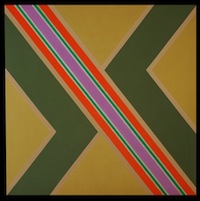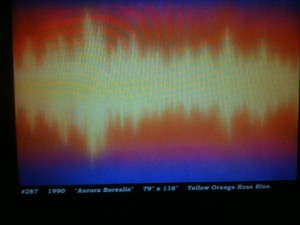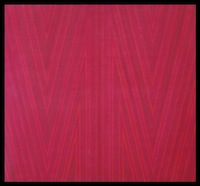
MODERNISM: JAMES HILLEARY AND COLOR
Born 1924, Washington D.C.
Bethesda, Maryland — Friday, October 12, 2012
Edited interview between James Hilleary and Brian Young, curator, UMUC, with assistance from Peggy Hilleary, the artist’s wife.
Brian: Jim, let’s start at the beginning. Where were you born? Are you a lifetime resident of the D.C. area? Where did you go to school early on?
Jim: Well, my family arrived in Georgetown in 1659. I went to school . . . I was educated by nuns at a parochial school in Georgetown. First through eighth (grades). I went to a boys school, Gonzaga.
Brian: Were you an art student in high school?
Jim: I was interested in art. I was interested in music. I did a lot of playing, professionally. I had a radio show.
Brian: What instrument did you play?
Jim: Piano.
Brian: So you were a professional pianist for a while?
Jim: Oh yes. I did a lot of that. Also did a lot of that in the army.
Brian: When did you serve in the army? Where and when?
Jim: Let’s see I graduated from high school in ’42 and immediately got my greetings from Uncle Sam and I was off.
Brian: Did you fight in World War II?
Jim: I won’t say I fought in World War II; but I was in World War II, but always on the safe side. Somebody was looking after me.
Brian: Were you a product of the GI Bill.
Jim: Very definitely. When I was in high school, a (university) would turn out about three architects a year. With the GI Bill it was more like a 150. It was a great contrast. I think the GI Bill was a great liberator for middle class society making things possible for people who otherwise couldn’t afford to.
Brian: After you leave the army, you take advantage of the GI Bill. Where did you choose to go to school? How did that work?
Jim: Well, when I was in high school, the best architectural school was Catholic University. When I got home, my family said, “You have been away so long why don’t you go to Catholic U?” So, I had by that time, Harvard or some other place in mind. But my family wanted me to be around for a while.
Brian: So you go to Catholic, you study architecture, was there ever a consideration to study music?
Jim: I had been studying music since I was this high. (Gestures) It was just there. Always was. I can’t imagine a time when it wasn’t. I guess to a certain extent I was sort of a clone of my father; we had two shared interests: art and music. That was all we ever talked about.
Brian: So you had an interest not just music but also the visual arts from your father.
Jim: Of very definitely. My father studied art at the Phillips. And I think I the first time I went there I probably crawled through the front door. I started going to the Phillips very early. I spent a whole life at the Phillips. It’s like the Phillips was for so many other people: artists of my time Gene Davis, Howard Mehring, everybody loved the Phillips.
Brian: Did you ever bump into those guys when you went there?
Jim: My childhood was before I met any of them.
Brian: Did you ever take classes from the Phillips?
Jim: I did take art classes, but not from the Phillips. . . . I learned a lot from looking. I learned the way Van Gogh used a brushstroke to express something. That’s all it took. I remember The Boathing Party. I wasn’t into Renoir particularly. But I thought the still life on the table was magnificent in an abstract way. I just learned a lot from the Phillips.
Brian: So you graduated from Catholic. Become an architect. When did visual arts, painting, become an activity that grew in significance or in stature.
Jim: It was after I built this house. Because I was frustrated for things I couldn’t afford. So I would execute things in the manner of. . . It just sort of opened the door to production.
Brian: What year was this house built?
Jim: 1957
Brian: The roof was changed and the studio added later? Yes. So you probably started painting when you first moved.
Jim: I had always painted and drawn. . . I have drawings that I made all through childhood.
Peggy: (One of) Sonja Henning.
Jim: And Shirley Temple. I was always drawing.
Brian: About what time did painting take on a larger role for you?
Jim: The stimulation was that I couldn’t afford what I would like to have. I was associated with Phillip Johnson on a project and resented the fact that he was rich (Laughter). He could buy what he wanted.
Brian: So you are a painter. You are stimulated in part visually by the Phillips Collection. But yet you are best known as someone who paints abstract work. At what point was the transition from painting things at the Phillips to working in abstraction?
Jim: It was the precision of architecture. Everything had to be so tight. So perfect. So accurate. It was kind of fun to just, you know, just surrender.
Brian: When you were painting, did you try to get into exhibitions and be known as a visual artist as well? Or is this something you were quietly pursuing on your own?
Peggy: (Jim) did some remodeling for Henri (Henrietta Ehrsam, gallerist in Alexandria, VA and D.C.).
Jim: I joined Henri when she was in Alexandria. I think possibly because of Howard (Mehring). We had a friend do accounting for Henri. So we were always hearing about Henri. . . I thought that is the kind of gallery I would like to be in because I admired the painting. . .
Jim, (returning to the remodeling project): I remember first thinking I would like to make the space very New York. But, then I realized how successful she had been down there on Royal Street in a house setting and how wonderful it was to have your paintings shown in her living space because you saw the possibility of having two things work together. So when we went up to P Street, . . . Henri was very successful with that residential quality and how well it worked for the artist because there was a compatibility and a warmth to it.
Peggy: (Adelyn) Breeskin (title) was the first person, that respectable, to recognize (Jim’s) work as being equal to anyone showing at the time. When she saw (Jim’s) “windows” that architectural period. You had a blue and gray, smoky, with wholes cut squares in it. . . She was very impressed. . .
Brian: What other artists did you know? Did you socialize with other visual artists? Was there camaraderie there?
Jim: I didn’t know any of the other artists well until Adelyn Breeskin (former director of the Baltimore Museum of Art) thought I ought to get better acquainted with all of them.
Peggy: We got to know Leon Berkowitz quite well.
Peggy: Ben Forgey always gave good reviews.
Jim: Oh yes. I had the good fortune of having mostly every show I did get reviewed.
Brian: I have a personal affinity for drawings. As for the Washington Color Painters, the drawings are secondary or at least in many of the exhibitions. What role did drawings play in your work? Did you do sketches for your work before you executed them?
Jim: Sometimes I would do drawing. Sometimes I would go further.
Peggy: You would sit up in bed doing pastel sketches.
Brian: I think you had different categories or different series as it were. It could be Reflections and Striae. How did you start the series? Where was the spark? What was your inspiration for starting a series and then ending it and starting a new one?
Jim: Well, I think everything was an outgrowth of what went before.
Peggy: The Monet Gardens, didn’t that inspire your Reflections?
Jim: Oh yes.
Brian: Tell me about what inspired you to make the really large works. Works that might be 13 or 14-feet across?
Jim: I guess I admired big paintings. I remember having a conversation with my father. I was having a show at Barbara Fiedler across the street from the Phillips. And my father was saying, ‘Why do you work large? Nobody has space for large works.’ And we walked into townhouse of Barbara Fiedler’s. There was the dining room and there were four big walls and each one of them had a big work on it. And, you know, it works. Why not?
Brian: How did you know when a series was over?
Jim: I saw everything as a continuation of what went before. It wasn’t until I saw that during those, that they were referred to as “the touch,” that there is a whole different direction.
Brian: This might be the Variations with the tendrils coming into each other.
Jim: I love doing those. I remember I used to hang out at a jazz club on Pennsylvania Avenue. One night the guy that I was with was leaving us. (I asked), ‘Why are you leaving so early?’ And he said, ‘we are going to walk up to Henri’s gallery on the canal because she has a big picture window in the front of the building.’ And she had this painting up. And they said it looks like the building is on fire.
Later on I think I made this walk with Carroll Sockwell looking at this painting looking like fire with this intense light. (It was Variation II, 1979)
Brian: I think a lot of people see your work as strictly abstract, that is, no discernible subject matter. Is that the case? Or are there things where maybe your work does reflect a figure or the landscape or sky or fire as you say?
Jim: When I was doing these (Variation Series) I always thought of the Sistine Ceiling (by Michelangelo).
Brian: So in the case of these Variations, you see one is the hand of God and the other being the hand of Adam?
Jim: Yeah that’s right. There is serenity there. . . calming you know.
Brian: If somebody saw fire in your work or thought that it was a meteor shower and they came up with things you didn’t come up with, what are your thoughts?
Jim: They have better vision than I have. (Laughter) I guess if they see something they want to see that is alright with me.
Brian: Tell me a little about your family. And do any of their activities influence your work.
Jim: We got married in 1953.
Peggy: August 1st. Then we took off on a three-month honeymoon abroad
Jim: Oh we had a great time.
Brian: Peggy, are you an artist at all, a musician?
Peggy: Not at all. No way. I used to think I drew well but that was many years ago. I haven’t done it since.
Jim: But she used to work for the National Gallery of Art.
Peggy: When I got out of college, a friend of mine was an art major. She got a job there at the Information Room. So they asked me to join too and I was there for a couple of years until Jim came along.
Brian: So, you met Jim at the National Gallery?
Peggy: Yes. He was dating a friend of mine.
Jim: We are all happy about the way it all turned out in the end.
Brian: How many kids do you have?
Peggy: Four
Brian: Are any of them artists?
Jim: Oh yes!
Peggy: The miniatures are done by our daughter.
Brian: I noticed you have a pond out front. And one of the pieces I included in the show is called Coy. So once you know the title and know that about you, it becomes a very autobiographical piece. . .
Jim: I used to enjoy going and feeding the Coy at the end of the day. They would come right up and eat out of my hands. I could pet them on the head. Coy are just amazing fish. . . They are like children.
Brian: I think that is a lovely image and I think that you captured some of the energy of the way that they all congregate and radiate out in a circle.
Brian: What did you enjoy more painting or architecture?
Jim: Painting. Definitely painting. Architecture is too demanding. I was sort of glad when it was all over.
Brian: When did you retire as an architect?
Jim: Around 1993 or 1994. I just let it go. It was a relief. Life was freer.
MODERNISM: JAMES HILLEARY AND COLOR will up on exhibit at the UMUC Gallery through February 3.






